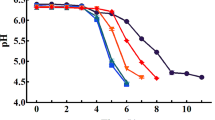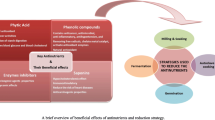Abstract
This study aimed to evaluate physical and chemical properties and nutritive values of citric acid by-product (CABP) from cassava and to compare its properties with those of cassava root meal (CRM). The physical properties analyzed were color, bulk density, angle of repose, particle size distribution, and ultrastructure morphology. The chemical properties were determined using proximate analysis. Regarding the physical results, the CABP’s color was darker, and its bulk density was greater by approximately 64.18% than those of the CRM (p < 0.05). The CABP’s angle of repose was significantly lower (p < 0.05) with a freer flow, and the particle size was classified as small with fewer polygonal starch granules but more than the CRM. Regarding the chemical composition results, the CABP contained 0.71% citric acid with pH 4.68 whereas crude protein, ether extract, crude fiber, and gross energy were 6.11%, 2.39%, 18.26%, and 3588.10 kcal/kg, respectively. CABP showed greater and significantly different crude proteins and ether extracts but less gross energy than the CRM (p < 0.05). The results imply that the CABP could be an alternative energy source and used as a CRM substitution in animal feed formulation.




Similar content being viewed by others
References
Ahmed OH, Husni MHA, Awang Noor AG, Hanafi MM. 2002. The removal and burning pineapple residue in pineapple cultivation on tropical peat: An Economic Viability Comparison. Pertanika Journal of Tropical Agricultural Science, 25, 47–51.
American Society of Agricultural Engineers (ASAE). 2008. Method of determining and expressing fineness of feed materials by sieving. American Society of Agricultural and Biological Engineers, St. Joseph, Michigan, USA.
Andriani Y, Safitri R, Abun. 2015. Improvement protein quality of cassava peel by solid substrate fermentation using cellulolytic microbial consortium. Scientific Papers-Animal Science Series: Lucrări Ştiinţifice-Seria Zootehnie, 63, 250–253.
Angumeenal AR, Venkappayya D. 2013. An overview of citric acid production. Food Science and Technology, 50, 367–370.
Association of American Feed Control Officials (AAFCO). 2014. Feed inspector’s manual, 5th ed. Association of American Feed Control Officials Inspection and Sampling Committee, Champaign, IL.
Association of Official Analytical Chemists (AOAC). 1990. Official Methods of Analysis, 15th ed. Association of Analytical Chemists, Arlington, USA.
Carr RL. 1965. Classifying flow properties of solids. Chemical Engineering Journal, 72, 69–72.
Dhillon GS, Brar SK, Kaur S, Verma M. 2013. Bioproduction and extraction optimization of citric acid from Aspergillus niger by rotating drum type solid-state bioreactor. Industrial Crops and Products, 41, 78–84.
Elferink EV, Nonhebel S, Moll HC. 2008. Feeding livestock food residue and the consequences for the environmental impact of meat. Journal of Cleaner Production, 16, 1227–1233.
Ezea I, Chiejina NV, Ogbonna JC. 2015. Biological production of citric acid in solid state cultures of Aspergillus niger. ChemXpress, 8, 201–207.
Fitzpatrick JJ, Barringer SA, Iqbal T. 2004. Flow property measurement of food powders and sensitivity of Jenike’s hopper design methodology to the measured values. Journal of Food Process Engineering, 61, 399–405.
Herrman T. 2001. Evaluating Feed Components and Finished Feeds. Kansas State University, USA.
Huang M, Zhang S. 2011. Starch degradation and nutrition value improvement in corn grits by solid state fermentation technique with coriolus versicolor. Brazilian Journal of Microbiology, 42, 1343–1348.
Junior NMP, Bruno DG. 2012. Impacts of feed texture and particle size on broiler and layer feeding patterns. World’s Poultry Congress 5–9 August 2012, Salvador, Brazil.
Kushwaha DK, Thomas EV, Maiti B, Ghosh BC, Baishakhi D. 2015. Assessment and optimization of bulk density and angle of repose of tea leaves for metering device using function desirability. International Journal of Scientific Engineering and Technology, 4, 36–39.
Li X, Li G, Li J, Yu Y, Feng Y, Chen Q, Komarneni S, Wang Y. 2016. Producing petrochemicals from catalytic fast pyrolysis of corn fermentation residual by-products generated from citric acid production. Renewable Energy, 89, 331–338.
Ma XF, Yu JG, Wan JJ. 2006. Urea and ethanolamine as a mixed plasticizer for thermoplastic starch. Carbohydrate Polymers, 64, 267–273.
Max B, Salgado JM, Rodríguez N, Cortés S, Converti A, Domínguez JM. 2010. Biotechnological production of citric acid. Brazilian Journal of Microbiology, 41, 862–875.
McDonald DE, Pethick DW, Mullan BP, Hapson DJ. 2001. Increasing viscosity of the intestinal contents alters small intestinal structure and intestinal growth, stimulates proliferation of enterotoxigenic Escherichia coli in newly-weaned pigs. British Journal of Nutrition, 86, 487–498.
Mohamad K, Abdul W, Hanafi I, Nadras O. 2011. Characterization of citric acid-modified tapioca starch and its influence on thermal behavior and water absorption of high-density polyethylene/natural rubber/thermoplastic tapioca starch blends. Polymer-Plastics Technology and Engineering, 50, 748–753.
Ndou SP, Archibold GB, Chimonyo M. 2013. Prediction of voluntary feed intake from physicochemical properties of bulky feeds in finishing pigs. Livestock Science, 155, 277–284.
Nwabanne JT. 2009. Drying characteristics and engineering properties of fermented ground cassava. African Journal of Biotechnology, 8, 873–876.
Papagianni M. 2007. Advances in citric acid fermentation by Aspergillus niger: biochemical aspects, membrane transport and modeling. Biotechnology Advances, 25, 244–263.
Philip KT. 2010. Livestock production: recent trends, future prospects. Philosophical Transactions of the Royal Society B: Biological Sciences, 365, 2853–2867.
Sanni L, Maziya DB, Akanya J, Okoro CI, Alaya Y, Egwuonwu CV, Okechukwu R, Ezedinma C, Akoroda M, Lemchi J, Okoro E, Dixon A. 2005. Standards for cassava products and guidelines for export. IITA, Ibadan, Nigeria.
Sarangbin S, Watanapokasin Y. 1999. Yam bean starch: a novel substrate for citric acid production by the protease-negative mutant strain of Aspergillus niger. Carbohydrate Polymers, 38, 219–224.
SAS. 2015. SAS University edition: Statistic, Version 6th ed. SAS inst. Inc., Cary, NC.
Stupak M, Vandeschuren H, Gruissem W, Zhang P. 2006. Biotechnological approaches to cassava protein improvement. Trends in Food Science and Technology, 17, 634–641.
Suiryanrayna MVAN, Ramana JV. 2015. Review of the effects of dietary organic acids fed to swine. Journal of Animal Science and Biotechnology, 6, 45–56.
Syamsu JA, Muhammad Y, Abdullah A. 2015. Evaluation of physical properties of feedstuffs in supporting the development of feed mill at farmers group scale. Journal of Advanced Agricultural Technologies, 2, 147–150.
Tuan VV, Delgado-Saborit JM, Harrison RM. 2015. Review: Particle number size distributions from seven major sources and implications for source apportionment studies. Atmospheric Environment, 122, 114–132.
Udensi EA, Osemele HO, Iweala OO. 2006. Effect of fermentation and germination on the physicochemical properties of Mucuna cochinchinens protein isolate. African Journal of Biotech, 5, 896–900.
Vasconcelos LM, Brito AC, Carmo CD, Oliveira PH, Oliveira EJ. 2017. Phenotypic diversity of starch granules in cassava germplasm. Genetics and Molecular Research, 16, 1–15.
Wiseman J. 1987. Feeding non-ruminant livestock. Butterworth & Co.Ltd. Published by Elsevier Ltd.
Acknowledgments
The authors would like to express their sincere thanks to the Fermentation Research Center for Value Added Agricultural Products Faculty of Technology, Khon Kaen University (KKU), and Research Group on Toxic Substances in Livestock and Aquatic Animals, KKU, for providing the use of the research facilities.
Funding
This work received a financial support from the Fermentation Research Center for Value Added Agricultural Products Faculty of Technology, Khon Kaen University (KKU), and Research Group on Toxic Substances in Livestock and Aquatic Animals, KKU. This work was also supported by the Thailand Research Fund (TRF) contract grant IRG5980010.
Author information
Authors and Affiliations
Corresponding author
Ethics declarations
Conflict of interest
The authors declare that they have no conflict of interest.
Additional information
Publisher’s note
Springer Nature remains neutral with regard to jurisdictional claims in published maps and institutional affiliations.
Rights and permissions
About this article
Cite this article
Tanpong, S., Cherdthong, A., Tengjaroenkul, B. et al. Evaluation of physical and chemical properties of citric acid industrial waste. Trop Anim Health Prod 51, 2167–2174 (2019). https://doi.org/10.1007/s11250-019-01917-y
Received:
Accepted:
Published:
Issue Date:
DOI: https://doi.org/10.1007/s11250-019-01917-y




